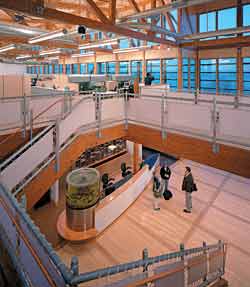The Green Market Reaches Critical Mass
Surveying the AEC community
Clearly, the market for green products is expanding and the implications for architects and specifiers intriguing and significant. But is green still a fad as some believe? Does green really cost more? Do manufacturers mostly view green as a customer "value-add" rather than as a strategic planning factor? Where are the reliable sources for green information? Throughout the 15-year history of the green building movement, architects, engineers, owners, and building product manufacturers have argued these and many other crucial questions, and with the prospects of a potentially broader market, they will continue to provoke debate.
For the first time, the AEC community supplies some answers in a new report released this month titledGreen Building SmartMarket Report 2006*.
Researched by McGraw-Hill Construction's Research and Analytics with support from the USGBC, the report analyzes the green design and construction marketplace.
|
||||||||||||||
It includes an overview of the green building movement, analysis of recently collected data from all sectors of the AEC, and interviews with leading building product manufacturers, federal agencies, and key green building innovators.
The survey, not only provides information on market trends, outlook, and economic impact, it analyses the perceptions of all players in the industry and what triggers green building. It also provides documentation that green building is no longer a fad and sole province of the environmentally aware, but an established, emerging market with a critical mass, significant economic and societal impact, and many opportunities for smart players.
SmartMarket found significant engagement in green building on the part of the AEC community: 40 percent of a representative sample of architects, engineers, contractors, and building owners are more than moderately involved in green building. Even more are actively involved: 60 percent of architects, engineers, and contractors are specifying and installing green products.
SmartMarket projects that between five and ten percent of new construction starts (non-residential) will be green projects by 2010. In 2000, the green marketplace was only a fraction of a percentage.
In 2004, green building comprised approximately 2 percent of the U.S. nonresidential market, which translates into approximately $3.3 billion. McGraw-Hill Construction forecasts U.S. non-residential construction starts will be worth approximately $204.5 billion in 2010. A projected growth of five to ten percent would mean between $10.2 billion and $20.5 billion in five years. On average, survey respondents expected the impact of green building on return on investment (ROI) to improve 6.6 percent.










